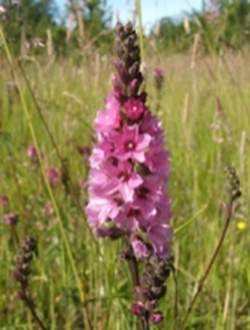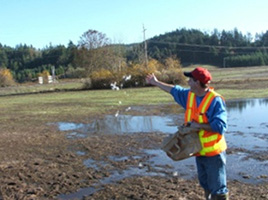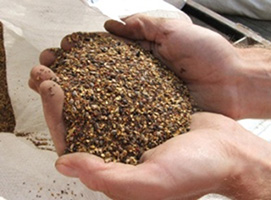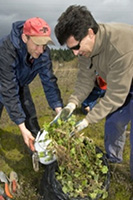Awards
Exemplary Ecosystem Initiatives — 2011
Oregon: Checkermallow and Wetland Restoration (OR 18: Fort Hill to Wallace Bridge)

Figure 1. The OR 18: Fort Hill-Wallace Bridge project impacted the habitat of Nelson's checkermallow, a wildflower protected under the Federal Endangered Species Act.
Source: Steven Gisler, ODOT
The Checkermallow and Wetland Restoration project, initiated by the Oregon Department of Transportation (ODOT), implements innovative techniques to mitigate environmental impacts resulting from the OR 18: Fort Hill to Wallace Bridge project. The OR 18 project brought several improvements to one of the most hazardous portions of highway in western Oregon, including the construction of a new interchange, highway overpass, and more than three miles of new travel lanes. While this project improved safety and accessibility, it also had significant environmental impacts by displacing over 16 acres of native wet prairie grasslands. This displacement was of particular concern, as Nelson's checkermallow (Sidalcea nelsoniana), a wildflower protected under the Federal Endangered Species Act grows in this habitat.
The Checkermallow and Wetland Restoration project worked to ensure restoration of Nelson's checkermallow. As the OR 18 project had to meet wetland mitigation requirements and as the checkermallow thrives in wet environments, ODOT combined its wetland mitigation and checkermallow efforts. ODOT partnered with several Federal agencies and non-profit organizations, including the U.S. Department of Agriculture, U.S. Fish and Wildlife Service, and the Institute for Applied Ecology to implement this project.
Prior to the start of the OR 18 project, ODOT identified and removed all checkermallow plants from the construction site, relocating 400 plants to a Federal nursery. ODOT then washed, separated, and replanted the checkermallows so they could continue to grow and yield seeds during the project's two-year term. ODOT took special care to ensure that the plants were relocated during winter, the best season for transplanting the species.
ODOT then acquired a 30-acre parcel of former agricultural fields which would serve as the new habitat for the displaced checkermallows. To establish the wetlands, ODOT removed invasive weeds and grasses as well as underground drainage tiles set in the early 20th century to drain the fields. The addition of earthen berms and shallow ponds further enhanced wetland creation. The Institute of Applied Ecology supported the effort by providing large amounts of native seeds to propagate the site. Upon completion of the wetlands mitigation site, ODOT replanted the checkermallows, along with approximately 60 pounds of harvested seed.
In 2010, monitoring reports found that this new wetland is home to many waterfowl and other wildlife. At least 100,000 new checkermallow seedlings and plant divisions now exist across the site, a tremendous accomplishment given that only 400 plants were originally displaced.
For more information, contact Steve Gisler, Oregon Department of Transportation, at steven.gisler@state.or.us.

Figure 2. ODOT removed invasive weeds and grasses, removed underground drainage tiles, and planted native seedlings to encourage wetlands restoration.
Source: Steven Gisler, ODOT
|

Figure 3. As part of the effort, the Institute for Applied Ecology provided large quantities of native seeds for the site.
Source: Steven Gisler, ODOT
|

Figure 4. Nelson's checkermallows are introduced to their new home.
Source: Steven Gisler, ODOT
|

